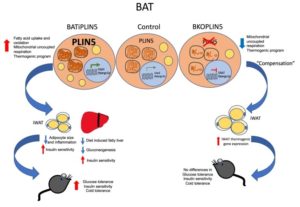Introduction –
According to a recent study headed by UT Southwestern researchers, increasing a protein contained in brown fat appears to lower blood sugar, enhance insulin sensitivity, and protect against fatty liver disease by remodeling white fat to a healthy condition.
The discovery, which was published online in Nature Communications, could eventually lead to new treatments for patients suffering from diabetes and related illnesses.

Bickel and his colleagues, including co-leader Violeta I. Gallardo-Montejano, M.D., an instructor at UTSW, discovered that brown fat may play a significant role in diabetes prevention. The researchers discovered this while examining perilipin 5 (PLIN5), a protein that coats lipid droplets inside cells, namely in Brown Adipose Tissue (BAT).
However, these cutting-edge findings have been demonstrated in mouse models, a confirmation in human physio-mimetic environment will be key to extrapolate such results into clinical trials.
Abstract-
The authors state that “Exposure of mice or humans to cold promotes significant changes in brown adipose tissue (BAT) with respect to histology, lipid content, gene expression, and mitochondrial mass and function. Herein we report that the lipid droplet coat protein Perilipin 5 (PLIN5) increases markedly in BAT during exposure of mice to cold. To understand the functional significance of cold-induced PLIN5, we created and characterized gain- and loss-of-function mouse models.
Enforcing PLIN5 expression in mouse BAT mimics the effects of cold with respect to mitochondrial cristae packing and uncoupled substrate-driven respiration. PLIN5 is necessary for the maintenance of mitochondrial cristae structure and respiratory function during cold stress.
We further show that promoting PLIN5 function in BAT is associated with healthy remodeling of subcutaneous white adipose tissue and improvements in systemic glucose tolerance and diet-induced hepatic steatosis. These observations will inform future strategies that seek to exploit thermogenic adipose tissue as a therapeutic target for type 2 diabetes, obesity, and nonalcoholic fatty liver disease.”
Source:
Gallardo-Montejano, V.I., Yang, C., Hahner, L. et al. Perilipin 5 links mitochondrial uncoupled respiration in brown fat to healthy white fat remodeling and systemic glucose tolerance. Nat Commun 12, 3320 (2021). https://doi.org/10.1038/s41467-021-23601-2


